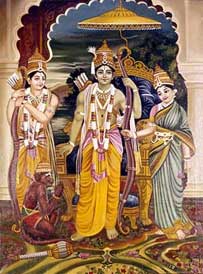Sri Srimad Bhaktivedanta Narayana Maharaja
March 21, 2005
Navadvipa Parikrama
Mamagachi, Modrumadvipa:
Many devotees have glorified this wonderful transcendental place, Sri Modrumadvipa. We should know that the pastimes which have taken place here have many important teachings for us.
The first teaching is the following:
This is the birthplace of Sri Vrndavana dasa Thakura. Sri Caitanya Mahaprabhu’s followers follow his teaching of:
trnad api sunicena
taror api sahisnuna
amanina manadena
kirtaniyah sada harih
[“One can chant the holy name of the Lord in a humble state of mind, thinking himself lower than the straw in the street. One should be more tolerant than the tree, devoid of all sense of false prestige and ready to offer all respects to others. ln such a state of mind one can chant the holy name of the Lord constantly.” (Siksastaka, verse 3)]
One should be more humble than a blade of grass, more tolerant than a tree, and should give respect to all others. So why is it that Sri Vrndavana dasa Thakura has said, “If anyone will criticize or minimize Sri Nityananda Prabhu, I will take a stick and beat him on the head.” Is this the mood of trnad api sunicena? Surely it is, because Sri Nityananda Prabhu is the Supreme Personality of Godhead and akhanda-guru-tattva (the complete principle of Sri Guru). Vrndavana dasa Thakura is giving this teaching to us – if anyone will criticize the Supreme Lord, Sri Guru or pure Vaisnavas, what should you do? Should you be tolerant? No. You should cut out their tongue with a knife. "Cut" means cut their arguments, and "knife" means knife-like sharp arguments from scriptures. This means you should speak conclusive philosoply in such a way that they cannot give a reply. They should be left speechless. Pure devotees cut out anarthas of the ignorant through his strong words from scripture.Vrndavana dasa Thakura says he will beat them with a stick. This also means strong preaching, leaving them beaten in their arguments and unable to continue their offences. If you cannot do that, you should cover your ears and quickly run and jump into the Ganges River with all your clothes on. Otherwise, a very dangerous reaction will come from the offense of hearing that blasphemy.
Ravana stole Srimati Sita-devi. Hanuman searched for her and finally went to Lanka. He wanted to personally take her to Lord Sri Rama, but she said, “No. You should inform Rama, and he will come here and take me.” Hanuman then burned Lanka to the ground as a punishment to Ravana. He was extremely angry. He did not manifest the external attributes of the mood of trnad api sunicena, but his mood was actually trnad api sunicena. If you are on the level of Hanuman, you can do as he did, otherwise preach, or leave that place.*[see endnote]
The second teaching is as follows:
Very close by here is the house of Sri Sarangadeva, a very powerful associate of Sri Gauranga. [Once, as Sri Gaursundara was returning home with Srivasa and Sri Sarangadeva, having just reprimanded Devananda Pandita, He turned to Sarangadeva and asked, "Why don't you accept a disciple? It must be an endeavor for you to do all the work in the asrama, to serve the Deities, and then to join Me in sankirtana." Sarangadeva replied, "I cannot find a qualified disciple, therefore I accept no one." Mahaprabhu said, "whomever you accept as a disciple will become qualified." Sarangadeva replied, "I will accept as a disciple the first person I meet tomorrow." He then paid his obeisances to the Lord and returned to his asrama. The next morning he awoke from sleep and went to take bath in the Ganges. There he saw the dead body of a boy floating in the water. Remembering Mahaprabhu's order, Sarangadeva brought that dead boy to the river bank and recited the diksa-mantra into his ear. Astonishingly, when the mantra entered the boy's ear he returned to life. Paying his prostrated obeisances at Sri Sarangadeva's feet he said, "Yesterday, on the occasion of my sacred thread ceremony, I was bitten by a poisonous black snake. I don't know what happened after that." When the boy's parents, relatives and friends heard that he was alive again, they came to the place of Sri Sarangadeva. They embraced the boy and said, "When you were bitten by that snake no remedy could save you. Since the body of a person who has died of a snake bite cannot be burned, we placed you in the Ganges, and by the mercy of Sri Sarangadeva you have returned to life." They wanted the boy, Murari, to go home with them, but he would not go. That boy, who later became known as Sri Murari Thakura, firmly vowed to spend his entire life in the service of Sri Sarangadeva. (Navadvipa-dhama parikrama)]
At Sri Sarangadeva's residence there was a huge bakula tree. Even today this ancient tree, which is completely hollow inside, stands as witness to the historic events.
This history is given to show the nature of guru-tattva. Sarangadeva is the epitome of Sri Guru, the ideal spiritual master, because when he gave the mantra to a dead body, that body came alive. Sad-gurus are so powerful. The living entities are like dead in this material world, and by the power of mantra they can be brought to spiritual life. Sarangadeva's disciple Murari was an ideal disciple. The disciple should not know anyone but his guru. These examples are to be followed.
The third teaching is as follows:
At the time of Rama-lila there was a huge banyan tree here, and Laksmana built a hut here. This was a very charming and attractive place. The Ganges was flowing nearby. There were many mango trees and cuckoo birds were singing. Srimati Sita-devi and Sri Ramacandra were very pleased to be here. Laksmana prabhu made a cottage for them to stay in during the time of their exile. One day, Sri Ramacandra was meditating and smiling. Sita-devi became curious and asked “Why are you smiling?” Lord Rama explained, “This place is extremely dear to me. In the future, in Kali-yuga, I will appear here as Sri Caitanya Mahaprabhu. I will accept sannyasa and leave my mother and wife weeping. My wife will weep in my mother's arms." Sita-devi asked, “Why will you do this? What happiness is there in giving unhappiness to your wife and your mother?” Lord Rama explained, “Prema has two aspects: sambhoga and vipramlambha, or meeting and separation. Without separation, the pleasure of meeting cannot be nourished. Unless meeting and separation both occur, it is not possible to relish the mellows of prema-rasa. In this pastime I will leave you and send you to the forest, and we will be separated for the rest of our lives. I will make a golden Deity of you and worship it.”
It is Lord Krsna’s nature to reciprocate with His devotees' love. Rama then said, “Later, when I appear as Caitanya Mahaprabhu, instead of you going to the forest and I worshipping your golden Deity, I will go to the forest and take sannyasa, and you will be left behind and worship my Deity. You will appear as Sri Visnupriya and worship me.” This separation mood is very relishable.
Later on, some time after Sita, Rama and Laksmana returned to Ayodhya, a resident there raised a doubt about Sita’s chastity – because she had stayed for such a long time without her husband in Lanka, the abode of Ravana. To set an example for the entire society, that even the wife of a king should be beyond others' doubts, Lord Rama asked Laksmana to take Sita to the asrama of Valmiki and leave her there. At that time Sita-devi was pregnant, and later she gave birth to two sons – Lav and Kush. Neither Lord Rama nor the other residents of the palace saw them as they were growing up. They were staying with their mother at the asrama of the sage Valmiki, who taught them how to sing the pastimes of Lord Rama (Ramayana) – up to the part where Lord Rama abandoned Sita. Valmiki taught them to sing in a wonderful way, with all bhavas, (transcendental emotions) laya (emotion-evoking ascending and descending scales), murchana (high and low pitches) and all the various types of musical arts.
As Lav and Kush were growing up and learning the art of reciting the Ramayana in that beautiful way, Lord Rama was in Ayodhya. He told his Gurudeva, Vasistha Rsi, “I want to perform a sacrifice.” Vasistha Rsi replied, “It is impossible. A married person cannot perform a sacrifice in the absence of his wife. You will have to call back Sita. Lord Rama refused to accept this proposal. He asked, “Is there any other way?” Vasistha Rsi replied that he remarry, and he rejected that proposal as well. Then Vasistha said, “You should make a golden Deity of Sita, and in her company you can perform the sacrifice. Lord Rama then had a golden Deity of Sita made, who was so beautiful that it looked exactly like her. He installed the Deity himself by prana-pratistha ceremony, and alongside that Deity he performed the sacrifice.
When Lav and Kush reached the age of about nine years, when they were brahmacaris, they went to Naimisaranya (near Ayodya), where Lord Rama was performing a Rajasuya sacrifice. At that time they sang the Ramayana in such a wonderful and pathetic way that everyone present was struck with wonder. Lord Rama was weeping bitterly. Laksmana, Bharata, Kausalya, Kaikeyi, Sugriva, Vibhisana and everyone else who heard their recitation were awestruck. They thought, "If Rama had sons, they would have been like this." Weeping bitterly, they were tasting the mellows of separation.
When the boys finished their recitation, Lord Rama told Laksmana to give them a reward and to inquire about their identity. Laksmana approached and asked them, “O brahmacaris, please accept this donation of gold coins in charity, and inform us who you are and who is your mother and father.” Those two very ideal brahmacaris replied, “We live in the asrama of Valmiki Rsi. There is very sweet water and so many flowering mango trees there. All the necessities we require are there. We have no need of the gold coins. Also, we are the disciples of Valmiki Rsi, so if you ask who our mother and father are, this is against the principles of religion. According to religious principles, the brahmacari and sannyasi have no material mother or father. The father is guru and the mother is mantra. You should not ask this question."
If someone asks me who is my father I will say, "Srila Bhakti Prajnana Kesava Gosvami Maharaja."
All were impressed by the boys' perfect character. In the meantime, Sita-devi was in her asrama and wondering, “My sons have been gone for so many hours. Where are they? Why are they so late?” After some time, they retuned, quite late at night, and Sita-devi asked them, “Where have you been?” They answered, “We have seen something quite astonishing. We went to Naimisaranya and there we saw a king performing a sacrifice. There was a golden Deity sitting next to him who looked exactly like you. The only difference was that you speak and this Deity did not speak.”
We can understand that Lav and Kush did not know that Lord Rama was their father, or who their father was. When Sita-devi heard these words from her two sons, she began to weep and thought to herself, “The King has abandoned the Queen, but Rama has not abandoned Sita.” Her two sons were looking and her and wondering, “Why is our mother crying?’
In the meantime, Lord Rama could understand, “These two brahmacaris are my sons.” He told Vasistha Rsi, “Send for Sita-devi and Lav and Kush. They should return here. Sita-devi can perform some activity whereby all the citizens of Ayodhya will have evidence that she is completely chaste.” Sita-devi was sent for, and she entered that assembly holding the hands of her two sons – one on each side – and her face was hanging down.
Lord Ramacandra requested her, “I have no doubt about your chastity, but please do something so that the residents of Ayodhya and everyone will know for all time that you are chaste. Sita-devi prayed, “O Prthivi-devi, O my dear mother, Mother Earth, if in my life I have never remembered any other man, if I have never had any relationship with any man other than Lord Rama, with my body, mind and words, then kindly accept me. Ravana touched me once, when I was helpless (Ravana had caught hold of Sita as he was kidnapping her), but not after that.” As soon as Sita-devi said these words, the earth opened up and Prthivi-devi, the predominating goddess of the Earth appeared there, sitting on a golden throne. She extended her arms and took Sita-devi on her lap, and then that golden throne sank back into the earth. The earth closed, and Sita-devi disappeared forever.
Lord Rama became overwhelmed in separation. Weeping, he became like a mad person and forgot everything. He took his bow and arrow and aimed his arrows at the earth. He said, “Return my Sita, or I will burn you to ashes.” Valmiki Rsi came forward and pacified Lord Rama. He said, “I have written up to here – not further. Now it is the time that your manifest pastimes in this world come to an end. Don’t be perturbed. You should know that Sita-devi has returned to Sanket-dhama, the transcendental Ayodhya in the spiritual sky, and she is waiting for you there. Now, wind up your pastimes and return to her there.” In this way Lav and Kush became the kings and remained in this world, and Rama left for the non-manifest Ayodhya in the spiritual sky.
At a dramatic performance, devotees continually weep as they hear the nectar of these pastimes. Then, the next day they return to hear the same pastimes again. If this is painful and separation is a bad thing, why do they hear such pastimes again and again? It is because there is great happiness in this separation.
Thus, when Lord Rama again appeared here in Navadvipa-dhama, in the golden form of Lord Gauranga, He again went to the forest.
ye yatha mam prapadyante
tams tathaiva bhajamy aham
mama vartmanuvartante
manusyah partha sarvasah
[“As all surrender unto Me, I reward them accordingly. Everyone follows My path in all respects, O son of Prtha.” (Bhagavad-gita 4.11)]
Lord Sri Krsna promises to reciprocate with the love of His devotees. So in this incarnation Sri Caitanya Mahaprabhu went to the forest and Visnupriya remained at home. He took sannyasa and in His absence Visnupriya-devi made the Deity of Lord Gauranga and worshiped that form. That Deity is present today, and we will have his darsana when we perform nagara-sankirtana in Navadvipa town.
Sri Sita-Rama ki jaya
Sri Vrndavana dasa Thakura ki jaya
Srimati Narayani devi ki jaya
Saranga-Murari ki jaya
Gaura Premanande, hari haribol.
[*Endnote - We cannot stop anger altogether, but if we simply become angry with those who blaspheme the Lord or the devotees of the Lord, we control our anger in Krsna consciousness. Lord Caitanya Mahäprabhu became angry with the miscreant brothers Jagai and Madhai, who blasphemed and struck Nityananda Prabhu. In His Siksastakam Lord Caitanya wrote, trinad api sunicena taror iva suhisnusa: “One should be humbler than the grass and more tolerant than the tree.” One may then ask why the Lord exhibited His anger. The point is that one should be ready to tolerate all insults to one’s own self, but when Krsna or His pure devotee is blasphemed, a genuine devotee becomes angry and acts like fire against the offenders. Krodha, anger, cannot be stopped, but it can be applied rightly. It was in anger that Hanuman set fire to Lanka, but he is worshiped as the greatest devotee of Lord Ramacandra. This means that he utilized his anger in the right way.]
Translator: Sripad Aranya Maharaja
Editor: Syamarani dasi
Transcriber: Vasanti dasi
Typist: Lalita-kisori dasi and Vasanti dasi
Foods Restricted on Ekadasi:
• Tomatoes, eggplants, cauliflower, broccoli, bell peppers, beets, bitter melon (karela), loki, parmal, toroi, kunli, drumsticks, bindi (ladies' fingers) and banana flowers
• Peas, chickpeas and all types of beans, including products made from beans (e.g., papadams, tofu, tempeh)
• All leafy vegetables (e.g., spinach, salads, cabbages) and leafy herbs like parsley, coriander leaves, celery and curry leaves
• Grains (e.g., millet, barley, farina, pasta, rice, corn) and all types of flour made from grains and beans (e.g., rice flour, chickpea flour, urad dahl flour)
• Starches from corn or grains, and products made from or mixed with these starches like baking soda, baking powder, certain soft drinks with corn syrup, custard, certain yoghurts and puddings, certain varieties of cream and cottage cheese, certain sweets and candies, and tapioca balls
• Oils made from grains (e.g., corn oil, mustard oil, sesame oil) and products fried in these oils (e.g., fried nuts, potato chips and other fried snack foods)
• Honey, and sweets made with starches
• Spices used on Ekadasi: black pepper, fresh ginger, pure salt and fresh turmeric, all taken from a new and clean package
• Spices not used on Ekadasi: hing (asafetida), sesame seeds, cumin, fenugreek, mustard, tamarind, fennel, cardamom and nutmeg









